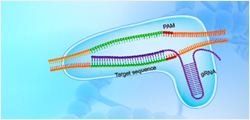Members of the rodent Ly49 receptor family control NK cell responsiveness and demonstrate allele specificity for MHC class I (MHC-I) ligands. For example, the rat Ly49i2 inhibitory NK cell receptor binds RT1-A1(c) but not other rat MHC class Ia or Ib molecules. RT1-A1(c) preferentially binds peptides with proline at the second, or P2, position, which defines it as an HLA-B7 supertype MHC-I molecule. Previously, our laboratory showed that mutations within the MHC-I supertype-defining B-pocket of RT1-A1(c) could lead to alterations in P2 anchor residues of the peptide repertoire bound by RT1-A1(c) and loss of recognition by Ly49i2. Although suggestive of peptide involvement, it was unclear whether the peptide P2 ... More
Members of the rodent Ly49 receptor family control NK cell responsiveness and demonstrate allele specificity for MHC class I (MHC-I) ligands. For example, the rat Ly49i2 inhibitory NK cell receptor binds RT1-A1(c) but not other rat MHC class Ia or Ib molecules. RT1-A1(c) preferentially binds peptides with proline at the second, or P2, position, which defines it as an HLA-B7 supertype MHC-I molecule. Previously, our laboratory showed that mutations within the MHC-I supertype-defining B-pocket of RT1-A1(c) could lead to alterations in P2 anchor residues of the peptide repertoire bound by RT1-A1(c) and loss of recognition by Ly49i2. Although suggestive of peptide involvement, it was unclear whether the peptide P2 anchor residue or alteration of the RT1-A1(c) primary sequence influenced Ly49i2 recognition. Therefore, we directly investigated the role of the P2 anchor residue of RT1-A1(c)-bound peptides in Ly49i2 recognition. First, fluorescent multimers generated by refolding soluble recombinant RT1-A1(c) with individual synthetic peptides differing only at the P2 anchor residue were examined for binding to Ly49i2 NK cell transfectants. Second, cytotoxicity by Ly49i2-expressing NK cells toward RMA-S target cells expressing RT1-A1(c) bound with peptides that only differ at the P2 anchor residue was evaluated. Our results demonstrate that Ly49i2 recognizes RT1-A1(c) bound with peptides that have Pro or Val at P2, whereas little or no recognition is observed when RT1-A1(c) is complexed with peptide bearing Gln at P2. Thus, the identity of the P2 peptide anchor residue is an integral component of MHC-I recognition by Ly49i2.



































